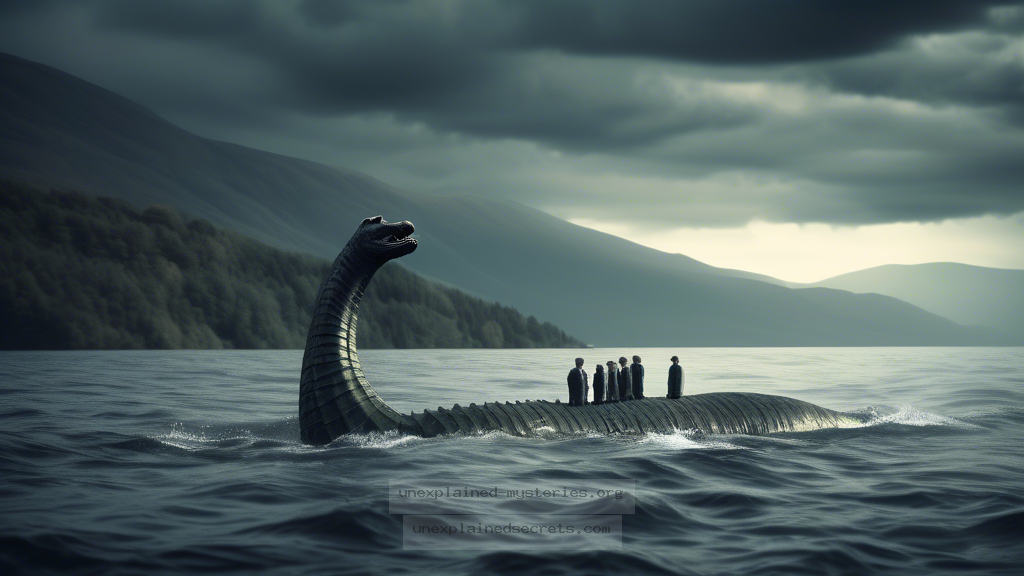What Recent Sonar Discoveries Reveal About the Loch Ness Monster Mystery?
What Recent Sonar Discoveries Reveal About the Loch Ness Monster Mystery?
The Loch Ness Monster, often affectionately called “Nessie,” has captivated the imagination of the world for decades. This enigma, purported to dwell in Scotland’s Loch Ness, is steeped in folklore, mystery, and a plethora of sightings ranging from the plausible to the downright bizarre. Despite numerous investigations and scientific endeavors, the question remains: is there something lurking beneath the surface of this deep, dark loch? Recent sonar discoveries have sparked renewed interest and debate, leading many to wonder if we are finally inching closer to uncovering the truth about Nessie. In this blog post, we will explore the findings of recent sonar expeditions, their implications, historical context, and the science behind these underwater investigations.
Historical Context of Loch Ness Monster Sightings
The Loch Ness Monster legend dates back to ancient times, with the first recorded sighting occurring in 565 AD when Saint Columba reportedly encountered a creature in the loch. Over the centuries, numerous sightings have been documented, with varying descriptions that often depict a large, serpentine creature. The modern fascination with Nessie began in the 1930s, when a photograph known as the “Surgeon’s Photograp” surfaced, purportedly showing the creature’s head and neck. This image, however, was later revealed to be a hoax. Nevertheless, the legend endured, spurring countless expeditions and investigations.
Throughout the latter half of the 20th century, various sonar and underwater photography projects were launched, but definitive evidence remained elusive. The mystery deepened as eyewitness accounts continued to pour in, yet skepticism grew as many sightings were often attributed to misidentified animals or natural phenomena. Recent technological advancements in sonar imaging, however, have reignited interest in the Loch Ness Monster and opened new avenues for exploration.
The Technology Behind Modern Sonar Discoveries
Recent sonar expeditions to Loch Ness have relied on advanced technology to probe its murky depths. One such technology is multibeam sonar, which emits sound waves to create detailed maps of the underwater landscape. This method not only identifies the topography of the loch but can also detect anomalies that could suggest the presence of large objects. In 2022, a team of researchers utilized this technology to scan the loch, uncovering intriguing sonar readings that sparked excitement among cryptozoologists and enthusiasts alike.
Another innovative approach involves the use of autonomous underwater vehicles (AUVs) equipped with sonar and cameras. These AUVs can navigate the loch’s depths and capture high-resolution images, providing insights into the underwater ecosystem that were previously unavailable. The combination of these technologies allows researchers to explore areas of the loch that are challenging to access, thus enhancing the chances of uncovering new evidence regarding Nessie’s existence.
Recent Sonar Findings: What Did They Discover?
In the most recent sonar expedition in Loch Ness, researchers reported several anomalies that could not easily be explained. Among the findings were unusual shapes and outlines detected at various depths of the loch. Some of these anomalies were large enough to suggest they could be biological entities, while others remained ambiguous. These discoveries have reignited discussions about the potential existence of a creature similar to the Loch Ness Monster.
The sonar data revealed objects that appeared to be larger than typical fish, leading scientists to speculate whether these could be large mammals or something entirely new. While some researchers remain skeptical, others argue that the unresolved anomalies warrant further investigation. The excitement surrounding these discoveries highlights the ongoing allure of the Loch Ness Monster and the possibility that new technology may finally provide the evidence needed to clarify the mystery.
Comparative Analysis: Loch Ness vs. Other Cryptids
The Loch Ness Monster is not alone in the world of cryptids. Other famous creatures include Bigfoot, the Chupacabra, and the Mokele-Mbembe, each with their own set of sightings and lore. A comparative analysis of these creatures reveals interesting parallels in the way they are perceived and investigated.
| Creature | Location | Key Characteristics | Evidence Type |
|---|---|---|---|
| Loch Ness Monster | Scotland | Serpentine, large | Sonar readings, eyewitness accounts |
| Bigfoot | North America | Large, ape-like | Footprints, videos, eyewitness accounts |
| Chupacabra | Puerto Rico, Americas | Reptilian, blood-sucking | Eyewitness accounts, carcasses |
| Mokele-Mbembe | Congo River Basin | Dinosaur-like | Eyewitness accounts, local legends |
Each of these creatures has inspired extensive research and debate, yet none have been conclusively proven to exist. The Loch Ness Monster stands out due to its combination of historical sightings, folklore, and the ongoing scientific interest in Loch Ness itself. This unique blend of elements keeps the legend alive, as researchers and enthusiasts alike continue to seek the truth.
Practical Implications of Sonar Research
The implications of sonar findings in Loch Ness extend beyond the mere quest for the Loch Ness Monster. Understanding the underwater ecosystem of the loch can provide valuable insights into conservation efforts, biodiversity, and the impact of human activity on this unique habitat. Additionally, the technology used in these explorations can be applied to other bodies of water, aiding in the study of aquatic life and environmental monitoring.
Furthermore, as the excitement around sonar discoveries grows, there is an opportunity for tourism in the area. The Loch Ness Monster has long been a draw for visitors, and renewed interest in its mystery could lead to increased economic benefits for the local community. This creates a delicate balance between conservation and tourism, as researchers must consider the impact of increased human activity on the loch’s ecosystem.
Alternative Perspectives: Skepticism and Belief
While many embrace the possibility of the Loch Ness Monster’s existence, skepticism remains a significant force in the discourse. Critics argue that the lack of concrete evidence, despite decades of investigation, suggests that Nessie is merely a myth. Eyewitness accounts, often cited as evidence, are frequently dismissed due to their subjective nature and the potential for misinterpretation.
Furthermore, some scientists assert that the sonar anomalies could be explained by natural phenomena, such as geological formations or schools of fish, rather than a large, unknown creature. This skepticism serves as a reminder of the importance of maintaining scientific rigor in the face of compelling folklore. Ultimately, the debate continues, with both believers and skeptics contributing to the rich tapestry of Loch Ness’s legacy.
Common Misconceptions About the Loch Ness Monster
Despite the extensive coverage of the Loch Ness Monster, several misconceptions persist. One common belief is that the creature is a dinosaur, specifically a plesiosaur, which has been popularized in various media. However, many researchers argue that this theory is unlikely, as the loch’s ecosystem and water temperatures would not support such a large, cold-blooded reptile.
Another misconception is that every sonar anomaly must be linked to Nessie. In reality, sonar technology can detect numerous underwater objects, including debris, rocks, and fish. While some anomalies may be unexplained, they do not necessarily point to the existence of a large creature.
Best Practices for Investigating the Loch Ness Mystery
For those intrigued by the prospect of investigating the Loch Ness Monster, there are several best practices to consider. First and foremost, approaching the subject with scientific rigor is essential. This means relying on credible sources, utilizing reliable technology, and maintaining an open yet skeptical mindset.
Additionally, collaborating with experts in the field of cryptozoology, biology, and marine science can provide valuable insights and enhance the credibility of any findings. Engaging with local communities and respecting the cultural significance of the Loch Ness Monster can also enrich the investigation, as local knowledge often plays a crucial role in understanding the lore surrounding the creature.
Future Developments and Ongoing Research
The future of Loch Ness Monster research is promising, with ongoing advancements in technology paving the way for more comprehensive investigations. Scientists are continually refining sonar technology, and the potential for integrating artificial intelligence into data analysis may yield new insights into the loch’s depths.
Moreover, as public interest in cryptozoology grows, funding and support for expeditions may increase, allowing for more frequent and extensive explorations. The possibility of uncovering new species or phenomena in Loch Ness remains tantalizing, and the curiosity surrounding Nessie will likely endure as long as the loch itself.
Conclusion
The mystery of the Loch Ness Monster continues to captivate both believers and skeptics alike, with recent sonar discoveries providing fresh intrigue. As we delve into the depths of Loch Ness, we must balance our fascination with the unknown with a commitment to scientific inquiry and environmental stewardship. While we may not yet have definitive proof of Nessie’s existence, the ongoing exploration of Loch Ness serves as a testament to the enduring allure of nature’s mysteries and the human desire to understand what lurks beneath the surface. Whether Nessie is real or merely a figment of our imagination, the quest for answers will undoubtedly continue, inviting future generations to join in the adventure. 💫
Other Articles
Recent Posts
- What Happened to Flight MH370? The Conspiracy Theories That Still Haunt Us
- What Secrets Lurk Within the Walls of the Infamous Trans-Allegheny Lunatic Asylum?
- What Evidence Supports the Existence of Bigfoot in the Pacific Northwest?
- What Happened to the Indus Valley Civilization? Unraveling the Mysteries of Ancient Urban Life
- Can Telepathy Be Scientifically Proven Through Laboratory Evidence?







